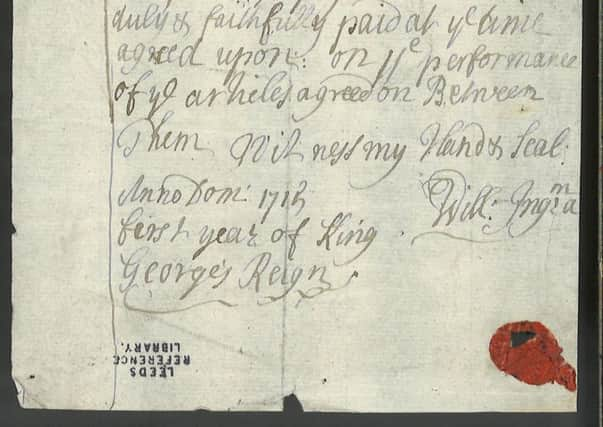Pocket money contract of aristocratic boy who had to buy his own shoes


But the document newly uncovered from the archive at one of Yorkshire’s grand country houses, in which an aristocratic lady lays out the terms for giving her son his pocket money, sheds intriguing light on the social mores of the time – in particular, the requirement that the boy must buy his own shoes.
Lady Isabella Ingram, wife of the 17th century MP and Vice-Admiral of Yorkshire, Arthur Ingram, 3rd Viscount of Irvine, appears to have gone to extraordinary lengths to negotiate with her youngest son, William.
Advertisement
Hide AdAdvertisement
Hide AdTheir home was the Tudor-Jacobean Temple Newsam House in east Leeds, whose archivists have unearthed a scrap of handwritten paper from 1715.
It states that William, who would have been around 14 at the time, would be entitled to 20 shillings each quarter, but that “William Ingram does promise to fund himself out of his allowance shoes, pen ink and paper copybooks.”
It adds: “Lady Isabella does promise that this sum shall be duly and faithfully paid at the time agreed upon on the performance of the articles agreed on between them.”
The sum of 20 shillings, or £1, would have been a considerable amount at the time – around £70 at today’s prices.
Advertisement
Hide AdAdvertisement
Hide AdThe mother and son agreement is finished with an official flourish, and a small wax seal.
William was the youngest of nine children born to Lady Isabella, whose portrait still hangs in the Crimson Bedroom at Temple Newsam.
Leila Prescott, curator at the house, said: “We don’t know exactly what the circumstances were which led to Lady Isabella and William drawing up this agreement, but what this document does give us is a quite touching insight into Temple Newsam as a family home.
“The house is famed for being a sprawling mansion where generations of well-to-do aristocrats and eccentric characters would enjoy a colourful and lavish lifestyle.
Advertisement
Hide AdAdvertisement
Hide Ad“But Temple Newsam was also a place where mothers and fathers raised children and tried to equip them for life as adults.
“It’s always fascinating to connect more with the people who have lived here through the ages, who have each left their imprint on the house during their time here and whose portraits we see hanging on the walls today.”
The pocket money agreement is among documents held by the West Yorkshire Archive Service in Leeds, which helps members of the public make use of them.
The formal nature of William’s pocket money agreement might not have been unfamiliar to him. It appears to have been drawn up some 13 years after the early death, at 36, of his father, who had been MP for Scarborough.
Advertisement
Hide AdAdvertisement
Hide AdHe made a will a few days before he died, giving half his estate to Lady Isabella, and £2,000 each in trust for his younger sons, though with several caveats.
A portrait reputed to be of Viscount Ingram hangs at Temple Newsam near that of his wife, and he also features in a landscape hunting scene by the Dutch painter Leonard Knyff.